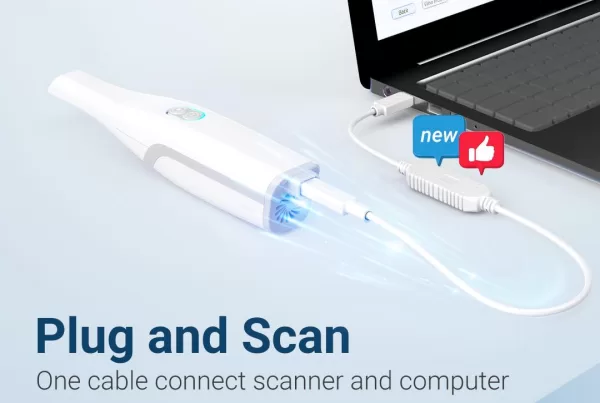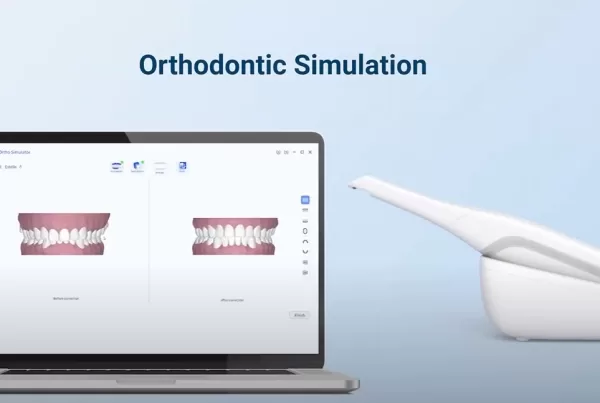Since the eighteenth century, traditional impression techniques have been used to make models of dental tissues. However, using traditional techniques poses a number of challenges. To overcome these difficulties, specialists developed intraoral scanning impression with IOS (intraoral scanner). A well-trained dental assistant can easily complete full-mouth 3D scans in minutes using intraoral scanners. In this article, we will learn something related to intraoral scanning and discuss some advantages of it.
An Introduction to Intraoral Scanning
What is an intraoral scanner? And how does an intraoral scanner work?
An intraoral scanner is a device used in dentistry to digitally make impressions. A light source is projected onto the area to be scanned by the scanner. Thousands of photographs are taken by the imaging cameras. After that, they are evaluated by scanning software and to create a precise 3D surface model of the teeth and gingiva. INO100 from BLZ can replace unpleasant dental impressions with highly accurate digital data acquired quickly and easily.
How much does an intraoral scanner cost?
Generally, your business goals, growth plans, and requirements actually determine the cost of your solution. A full system of digital dentistry has the potential to save money on many aspects. Impression material, provisional crowns, office time, and laboratory fees, etc. It is estimated that dentists who transition to office CAD/CAM systems can save 60 to 70 percent on their dental bills.
Is intraoral scanning easy? (How to use intraoral scanner ?)
Yes, it is simple. You can run an intraoral scanner if you can operate a cell phone. Most intraoral scanner manufacturers provide scan guidelines. The guidelines explain how to scan for specific indications. And you will improve your speed as you practice.
How Intraoral Scanning Upgrades Your Workflow? (Intraoral Scanner vs Impression)
Higher accuracy
Numerous investigations has proven the high accuracy of intraoral scanning. If you want to check it out for your self , the following study can help you know some of it. We can take some conclusions within the restrictions of this study.
Firstly, digital impressions showed more accuracy and less precision than traditional impressions.
Secondly, digital impressions showed better occlusal fitness.
Thirdly, for single crown manufacture, digital impressions could be a substitute to traditional impressions.
By removing traditional impressions from your workflow, you eliminate the most common cause of error in your lab: your impression.
Saving costs
It is heared that go digital can help the clinic save a lot of bills. Many of you may be concerned about this. So, in this paragraph, we are going to make a comparison.
Impression material and shipping
Using an intraoral scanner can save you a lot of money. Physical impressions needs all these from PVS material to model plaster. However,the digital workflow virtually eliminates all these stuffs. Not to mention the savings on shipping and storage of digital scanning.
Time savings
Many studies have proven that intraoral scanners can also save time. For instance, scanning a patient digitally only takes five minutes. There was no need for imprint material, no waiting for the PVS to dry and no mess. In conclusion, it’s a significant change that allows you to see more patients in less time.
Faster workflows
For some doctors, the digital workflow allows them to complete nearly the same amount of work in half the time. With an intraoral scanner, a doctor can easily provide a completely new crown to a patient who has a broken one without cooperating with a dental lab.
Improving communication with patients
Increase treatment acceptance by enthusing patients
A 3D scan on screen can also be used to communicate with the patient by visualizing treatment options.
Apps for smile design are available. Furthermore, monitoring and simulation apps allow doctors to show patients the expected outcomes of their orthodontic treatment. It will be much easier to communicate with your patients and to excite them at each visit, thereby increasing treatment acceptance.
Provide more treatment possibilities
The advantage of digital dentistry is that it allows you to progress over time. You begin with intraoral scanning and gradually improve your processes by adding other treatments. Do you want to start making crowns, for example? Why not grind them yourself insted of asking someone else? It’s possible for you.

